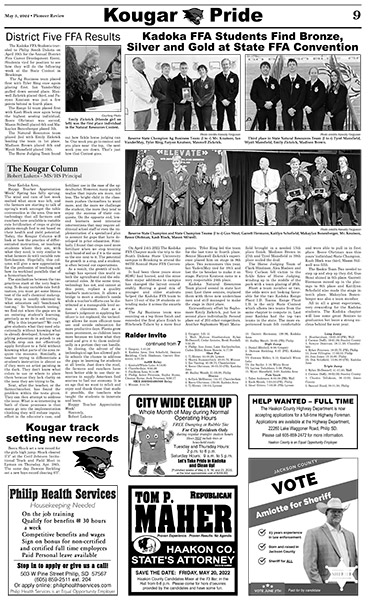Happy Teacher Appreciation Week! Spring has fully sprung. The wind and rain of last week melted what snow was left, and the farmers are starting to talk of spring’s work amongst the table conversation in the area. One new technology that all farmers and ranchers have available is variable rate fertilization of crops or giving plants enough food to eat based on their health and yield potential. Today, the Kougar Column will look at how the practice of differentiated instruction, or teaching students where they are, with what they need, is very similar to what farmers do with variable rate fertilization. Hopefully, this column will give a new appreciation for the profession of teaching and how its workload parallels that of a farmer/rancher.
The similarities between the two practices start at the very beginning. To do any variable rate fertilization, you must get some litmus test of the soil’s chemical makeup. This step is nearly identical to what educators call ‘benchmark testing.’ In ‘benchmark testing,’ we find out where the gaps are in an entering student’s learning, precisely as we do in soil testing.
Why is this important? We can’t give students what they need educationally without knowing what is already developed. A rancher applying potassium or potash to an alfalfa crop can not effectively apply fertilizer to a field without knowing what parts of the area require
the resource. Similarly, a teacher trying to differentiate a student’s instruction is almost as if they were an artist painting in the dark. They don’t know what colors to use or where to place them because they lack clarity on the issue they are trying to fix.
Next, after the teacher, or the farmer/rancher, has found the problem within the tests given. They can then attempt to address the issue. What is so interesting in both of these processes is that many go into the implementation thinking they will reduce inputs, effort in the educator’s case, and fertilizer use in the case of the agriculturist. However, many quickly realize that inputs are more, not less. The bright child in the classroom pushes themselves to want more, and the more we challenge the student, the more they tend to enjoy the success of their conquests. On the opposite end, low end learners need intensive interventions that may require additional school staff or even the implementation of a specialized plan to account for gaps that have developed in prior education. Similarly, I found that crops need more fertilizer when we stop treating each band of soil as if it is the same as the one next to it. The potential for growth in a crop, and a student, is often beyond our expectations.
As a result, the growth of technology has opened this world on both the agricultural and the educational sides. At the same time, technology has not, and cannot at this point, replace a quality teacher’s instruction. It allows a bridge to meet a student’s needs while a teacher’s efforts can be distributed at a manageable level across a classroom. Just as a farmer’s judgment in applying fertilizer is not replaced, the technology allows for more efficient time use and avoids exhaustion for more productive days. Plants grow more prominent, as children learn
more because we know what they need and give it to them individually in a portion they can handle.
In closing, the advent of the technological age has allowed public schools the chance to address the gaps in learning for students at all levels. Just down the road, the farmers and ranchers have been better able to use their resources to supply American food sources to fuel our economy. It is an age that we want to relish and enjoy and thank those that made it possible, the teachers who taught the students to innovate and learn.
Happy Teacher Appreciation Week!
Sincerely,
Robert Lukens

